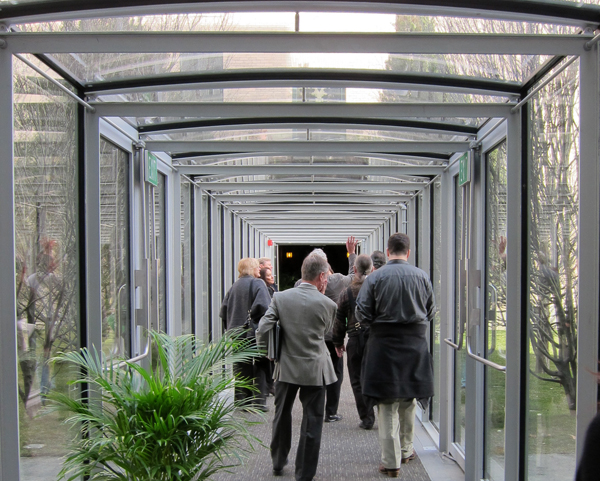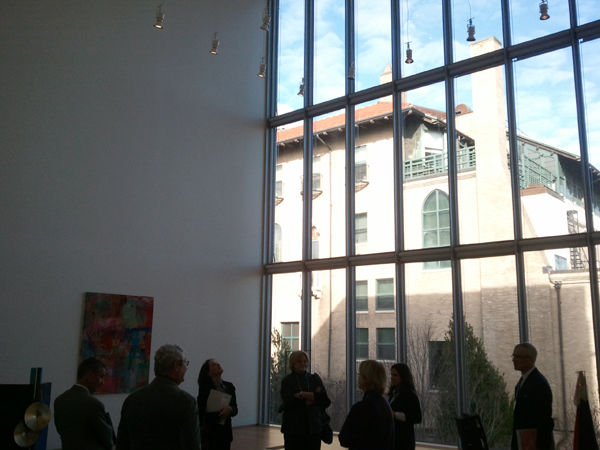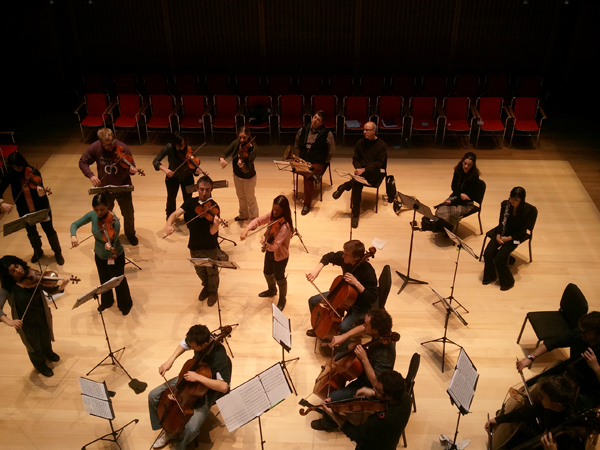Inside the Isabella Stewart Gardner Museum's New Renzo Piano Wing
 The new Renzo Piano wing at the Isabella Stewart Gardner Museum. (Photo by Matthew Reed Baker)
The new Renzo Piano wing at the Isabella Stewart Gardner Museum. (Photo by Matthew Reed Baker)
New wings and new buildings have been sprouting up around Boston like postmodern tulips over the past few years, and yesterday the Isabella Stewart Gardner Museum got its turn. For those of you unaware of why this is a particularly big deal, this wing is the culmination and final point on one of our city’s most heated arts controversies. The extremely simplified version (which is all you need) goes as follows:
When she died in 1924, legendary arts patron Isabella Stewart Gardner stipulated in her will that nothing in her collection of Rembrandts and priceless artifacts should be removed or changed upon her death, her house to be preserved hereafter — break that rule, and it all goes to Harvard. But over the years, the Gardner Museum recognized that its relentless stasis was getting stale — many people have likened the place to a mausoleum, albeit a delightful one — and the space was too cramped to house the collection and the various educational and performing arts programs it hosts to keep people coming in the door. Voila, a new wing is proposed, with museum director Anne Hawley and Pritzker-winning international superstarchitect Renzo Piano at the helm. Cue the various protests and legal brouhaha over whether a new wing will “change” the museum in a way that breaches the will. Hawley wins out, wing gets built, and here we are on a January morning checking it out for the first time.
 Architect Renzo Piano (left) and museum director Anne Hawley (right) spoke in Calderwood Hall yesterday. (Photos by Janelle Nanos)
Architect Renzo Piano (left) and museum director Anne Hawley (right) spoke in Calderwood Hall yesterday. (Photos by Janelle Nanos)
So it’s momentous that anything changes at the Gardner, let alone something as big as a new 70,000-square-foot wing. And at the press preview, the three speakers made great pains to wax triumphant while being clear they knew what was at stake. “[The museum] could not survive it’s current level of use,” said Gardner board chair Barbara Hostetter. “The challenge for us was to think of the impossible.” Or as Hawley put it, “We have struggled with the idea that the Gardner Museum is a total work of art … and now Renzo has given us another work of art.” Even Piano himself made sure to pay due respect to such a unique challenge: “It was not an easy job. You cannot compete with magic.”
 The old palace, as seen reflected in the glass corridor that now connects it to the new wing. (Photo by Matthew Reed Baker)
The old palace, as seen reflected in the glass corridor that now connects it to the new wing. (Photo by Matthew Reed Baker)
And indeed, anyone approaching the old palace can’t help but be startled by the contrast between its earth-toned stateliness and the fleet, sea-green contemporary wing behind it. Personally, I like that contrast, and the effect is heightened further when you enter the Piano wing in the museum’s new entrance off Evans Way. To get into the old palace you walk through a glass corridor that leads you from 2012 back into 1902, and the effect is dramatic. Where the palace is dark, cozy, and time-locked, the Piano wing is light, airy, and contemporary. Where the palace is all about enclosed spaces, the Piano wing is all about glass panels giving you views outside.
 Inside the glass corridor that links the new wing and the old palace. (Photo by Janelle Nanos)
Inside the glass corridor that links the new wing and the old palace. (Photo by Janelle Nanos)
Indeed, the palace itself has never looked better, with lush plantings in the courtyard, and a breathtaking restoration of the Tapestry Room. Over the past 85 years, it’s served as a “temporary” concert hall, but now the huge space and vast tapestries can yield their full effect, transporting you into what looks like a medieval banquet room. The Mercer-tiled floors have been scrubbed clean, the ancient French fireplace restored, and Gardner’s precious objects put back in place. When you visit the Gardner, make this room your first stop: The rest of the museum will shine brighter for it.
 The restored Tapestry Room inside the palace. (Photo by Janelle Nanos)
The restored Tapestry Room inside the palace. (Photo by Janelle Nanos)
As for the Piano wing, this much can be said: It doesn’t try to wow you, and that’s a good thing. After all, it’s not meant to upstage its older sister. Even more, my caveat for curious visitors is that they shouldn’t sightsee this new landmark and expect it to be packed with new art, like the MFA’s lauded Americas wing. This is a functional building, meant to house those educational and performing arts programs, thus freeing up the main museum for its core purpose.
And here, functionality and aesthetics are perfect partners. The wing has a lovely, uncluttered feel, and every detail is beautifully designed, from the kelly-green elevator walls to the vermilion seats in Calderwood Hall. Meanwhile, the special exhibition gallery is a wonder, with its retractable ceiling and 36-foot-high glass windows overlooking the palace.
 The new special exhibition gallery with a stunning view of the old palace through the window. (Photo by Matthew Reed Baker)
The new special exhibition gallery with a stunning view of the old palace through the window. (Photo by Matthew Reed Baker)
Best of all is Calderwood Hall. It’s a jewel box of a concert space, with three balconies, 296 seats, and sterling acoustics. At the end of our tour, we watched an informal concert by the Gardner Museum’s resident chamber orchestra, A Far Cry. With a warm balance of bass and treble and little or no reverb, you felt as if this 42-foot-high cube was actually a perfectly EQed pair of headphones. And with quietly soaring music cradled by warmly lit wooden walls, you had to agree with Piano’s take on his own building: “We found a poetic language in two things. One is sound, and the other one is light.”
 Chamber orchestra A Far Cry performs in Calderwood Hall. (Photo by Matthew Reed Baker)
Chamber orchestra A Far Cry performs in Calderwood Hall. (Photo by Matthew Reed Baker)


